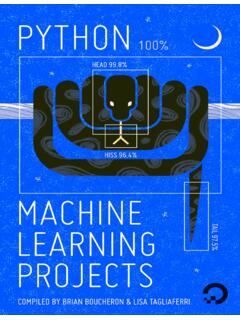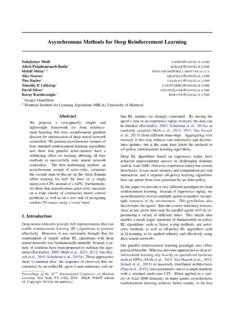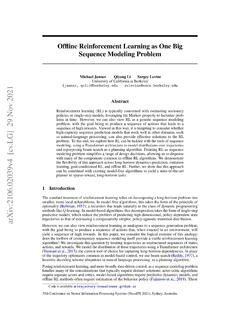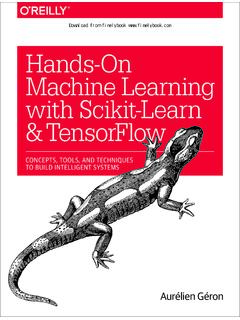Transcription of Machine Learning Projects - DigitalOcean
1 This work is licensed under a Creative Commons Attribution-NonCommercial-ShareAlike 978-0-9997730-2-4 Python Machine Learning ProjectsWritten by Lisa Tagliaferri, Michelle Morales, Ellie Birbeck, andAlvin Wan, with editing by Brian Hogan and Mark DrakeDigitalOcean, New York City, New York, USAP ython Machine Learning Projects1. Foreword2. Setting Up a Python Programming Environment3. An introduction to Machine Learning4. How To Build a Machine Learning Classifier in Python with Scikit-learn5. How To Build a Neural Network to Recognize Handwritten Digits withTensorFlow6. Bias-Variance for deep reinforcement Learning : How To Build a Botfor Atari with OpenAI GymForewordAs Machine Learning is increasingly leveraged to find patterns, conductanalysis, and make decisions without final input from humans, it is ofequal importance to not only provide resources to advance algorithmsand methodologies, but to also invest in bringing more stakeholders intothe fold.
2 This book of Python Projects in Machine Learning tries to do justthat: to equip the developers of today and tomorrow with tools they canuse to better understand, evaluate, and shape Machine Learning to helpensure that it is serving us book will set you up with a Python programming environment ify o u don t have one already, then provide you with a conceptualunderstanding of Machine Learning in the chapter An introduction toMachine Learning . What follows next are three Python machinelearning Projects . They will help you create a Machine Learning classifier,build a neural network to recognize handwritten digits, and give you abackground in deep reinforcement Learning through building a bot chapters originally appeared as articles on DigitalOceanCommunity, written by members of the international software developercommunity.
3 If you are interested in contributing to this knowledge base,consider proposing a tutorial to the Write for DOnations program DigitalOcean offers payment to authors and provides amatching donation to tech-focused Books in this SeriesIf you are Learning Python or are looking for reference material, you candownload our free Python eBook, How To Code in Python 3 which isavailable via other programming languages and DevOps engineering articles,our knowledge base of over 2,100 tutorials is available as a Creative-Commons-licensed resource via Up a Python Programming EnvironmentWritten by Lisa TagliaferriPython is a flexible and versatile programming language suitable formany use cases, with strengths in scripting, automation, data analysis, Machine Learning , and back-end development.
4 First published in 1991 thePython development team was inspired by the British comedy groupMonty Python to make a programming language that was fun to 3 is the most current version of the language and is considered tobe the future of tutorial will help get your remote server or local computer set upwith a Python 3 programming environment. If you already have Python3 installed, along with pip and venv, feel free to move onto the nextchapter!PrerequisitesThis tutorial will be based on working with a Linux or Unix-like (*nix)system and use of a command line or terminal environment. Both macOSand specifically the PowerShell program of Windows should be able toachieve similar 1 Installing Python 3 Many operating systems come with Python 3 already installed. You cancheck to see whether you have Python 3 installed by opening up aterminal window and typing the following:python3 -VYou ll receive output in the terminal window that will let you knowthe version number.
5 While this number may vary, the output will besimilar to this:OutputPython you received alternate output, you can navigate in a web browser in order to download Python 3 and install it to your machineby following the you are able to type the python3 -V command above andreceive output that states your computer s Python version number, youare ready to 2 Installing pipTo manage software packages for Python, let s install pip, a tool that willinstall and manage programming packages we may want to use in ourdevelopment you have downloaded Python from , you should have pipalready installed. If you are on an Ubuntu or Debian server or computer,you can download pip by typing the following:sudo apt install -y python3-pipNow that you have pip installed, you can download Python packageswith the following command:pip3 install package_nameHere, package_name can refer to any Python package or library, suchas Django for web development or NumPy for scientific computing.
6 So ifyou would like to install NumPy, you can do so with the command pip3 install are a few more packages and development tools to install toensure that we have a robust set-up for our programming environment:sudo apt install build-essential libssl-dev libffi-dev python3-devOnce Python is set up, and pip and other tools are installed, we can setup a virtual environment for our development 3 Setting Up a Virtual EnvironmentVirtual environments enable you to have an isolated space on your serverfor Python Projects , ensuring that each of your Projects can have its ownset of dependencies that won t disrupt any of your other up a programming environment provides us with greatercontrol over our Python Projects and over how different versions ofpackages are handled.
7 This is especially important when working withthird-party can set up as many Python programming environments as youwant. Each environment is basically a directory or folder on your serverthat has a few scripts in it to make it act as an there are a few ways to achieve a programming environment inPython, we ll be using the venv module here, which is part of thestandard Python 3 you have installed Python with through the installer available , you should have venv ready to install venv into an Ubuntu or Debian server or Machine , you caninstall it with the following:sudo apt install -y python3-venvWith venv installed, we can now create environments. Let s eitherchoose which directory we would like to put our Python programmingenvironments in, or create a new directory with mkdir, as in:mkdir environmentscd environmentsOnce you are in the directory where you would like the environmentsto live, you can create an environment.
8 You should use the version ofPython that is installed on your Machine as the first part of the command(the output you received when typing python -V). If that version was Python , you can type the -m venv my_envIf, instead, your computer has Python installed, use thefollowing -m venv my_envWindows machines may allow you to remove the version numberentirely:python -m venv my_envOnce you run the appropriate command, you can verify that theenvironment is set up be , pyvenv sets up a new directory that contains a few itemswhich we can view with the ls command:ls my_envOutputbin include lib lib64 shareTogether, these files work to make sure that your Projects are isolatedfrom the broader context of your local Machine , so that system files andproject files don t mix.
9 This is good practice for version control and toensure that each of your Projects has access to the particular packagesthat it needs. Python Wheels, a built-package format for Python that canspeed up your software production by reducing the number of times youneed to compile, will be in the Ubuntu share use this environment, you need to activate it, which you can achieveby typing the following command that calls the activate script:source my_env/bin/activateYour command prompt will now be prefixed with the name of yourenvironment, in this case it is called my_env. Depending on what versiono f Debian Linux you are running, your prefix may appear somewhatdifferently, but the name of your environment in parentheses should bethe first thing you see on your line:(my_env) sammy@sammy:~/environments$This prefix lets us know that the environment my_env is currentlyactive, meaning that when we create programs here they will use onlythis particular environment s settings and : Within the virtual environment, you can use the command python instead of python3, and pip instead of pip3 if you wouldprefer.
10 If you use Python 3 on your Machine outside of an environment,you will need to use the python3 and pip3 commands following these steps, your virtual environment is ready to 4 Creating a Hello, World ProgramNow that we have our virtual environment set up, let s create atraditional Hello, World! program. This will let us test our environmentand provides us with the opportunity to become more familiar withPython if we aren t do this, we ll open up a command-line text editor such as nano andcreate a new file:(my_env) sammy@sammy:~/environments$ nano the text file opens up in the terminal window we ll type out ourprogram:print("Hello, World!")Exit nano by typing the CTRL and X keys, and when prompted to savethe file press you exit out of nano and return to your shell, let s run theprogram:(my_env) sammy@sammy:~/environments$ python program that you just created should cause yourterminal to produce the following output:OutputHello, World!








